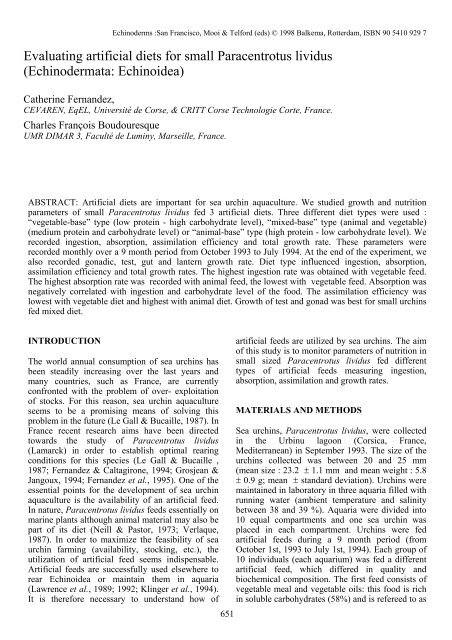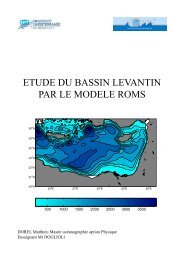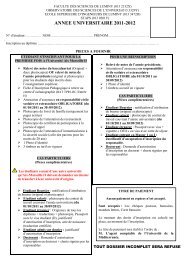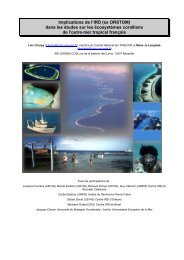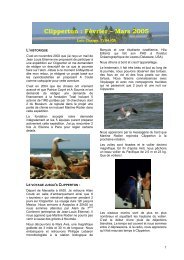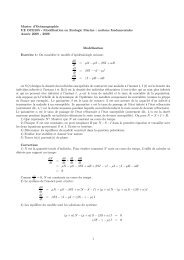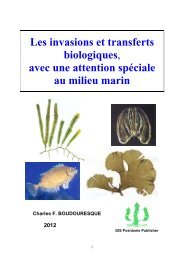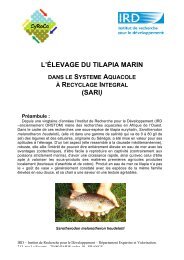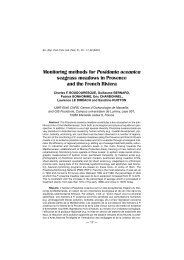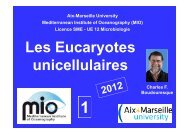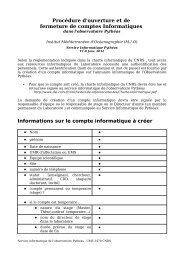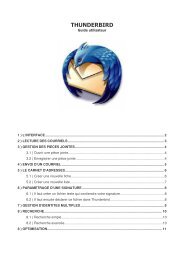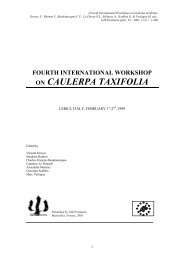Evaluating artificial diets for small Paracentrotus lividus - Centre d ...
Evaluating artificial diets for small Paracentrotus lividus - Centre d ...
Evaluating artificial diets for small Paracentrotus lividus - Centre d ...
Create successful ePaper yourself
Turn your PDF publications into a flip-book with our unique Google optimized e-Paper software.
Echinoderms :San Francisco, Mooi & Tel<strong>for</strong>d (eds) © 1998 Balkema, Rotterdam, ISBN 90 5410 929 7<br />
<strong>Evaluating</strong> <strong>artificial</strong> <strong>diets</strong> <strong>for</strong> <strong>small</strong> <strong>Paracentrotus</strong> <strong>lividus</strong><br />
(Echinodermata: Echinoidea)<br />
Catherine Fernandez,<br />
CEVAREN, EqEL, Université de Corse, & CRITT Corse Technologie Corte, France.<br />
Charles François Boudouresque<br />
UMR DIMAR 3, Faculté de Luminy, Marseille, France.<br />
ABSTRACT: Artificial <strong>diets</strong> are important <strong>for</strong> sea urchin aquaculture. We studied growth and nutrition<br />
parameters of <strong>small</strong> <strong>Paracentrotus</strong> <strong>lividus</strong> fed 3 <strong>artificial</strong> <strong>diets</strong>. Three different diet types were used :<br />
“vegetable-base” type (low protein - high carbohydrate level), “mixed-base” type (animal and vegetable)<br />
(medium protein and carbohydrate level) or “animal-base” type (high protein - low carbohydrate level). We<br />
recorded ingestion, absorption, assimilation efficiency and total growth rate. These parameters were<br />
recorded monthly over a 9 month period from October 1993 to July 1994. At the end of the experiment, we<br />
also recorded gonadic, test, gut and lantern growth rate. Diet type influenced ingestion, absorption,<br />
assimilation efficiency and total growth rates. The highest ingestion rate was obtained with vegetable feed.<br />
The highest absorption rate was recorded with animal feed, the lowest with vegetable feed. Absorption was<br />
negatively correlated with ingestion and carbohydrate level of the food. The assimilation efficiency was<br />
lowest with vegetable diet and highest with animal diet. Growth of test and gonad was best <strong>for</strong> <strong>small</strong> urchins<br />
fed mixed diet.<br />
INTRODUCTION<br />
The world annual consumption of sea urchins has<br />
been steadily increasing over the last years and<br />
many countries, such as France, are currently<br />
confronted with the problem of over- exploitation<br />
of stocks. For this reason, sea urchin aquaculture<br />
seems to be a promising means of solving this<br />
problem in the future (Le Gall & Bucaille, 1987). In<br />
France recent research aims have been directed<br />
towards the study of <strong>Paracentrotus</strong> <strong>lividus</strong><br />
(Lamarck) in order to establish optimal rearing<br />
conditions <strong>for</strong> this species (Le Gall & Bucaille ,<br />
1987; Fernandez & Caltagirone, 1994; Grosjean &<br />
Jangoux, 1994; Fernandez et al., 1995). One of the<br />
essential points <strong>for</strong> the development of sea urchin<br />
aquaculture is the availability of an <strong>artificial</strong> feed.<br />
In nature, <strong>Paracentrotus</strong> <strong>lividus</strong> feeds essentially on<br />
marine plants although animal material may also be<br />
part of its diet (Neill & Pastor, 1973; Verlaque,<br />
1987). In order to maximize the feasibility of sea<br />
urchin farming (availability, stocking, etc.), the<br />
utilization of <strong>artificial</strong> feed seems indispensable.<br />
Artificial feeds are successfully used elsewhere to<br />
rear Echinoidea or maintain them in aquaria<br />
(Lawrence et al., 1989; 1992; Klinger et al., 1994).<br />
It is there<strong>for</strong>e necessary to understand how of<br />
651<br />
<strong>artificial</strong> feeds are utilized by sea urchins. The aim<br />
of this study is to monitor parameters of nutrition in<br />
<strong>small</strong> sized <strong>Paracentrotus</strong> <strong>lividus</strong> fed different<br />
types of <strong>artificial</strong> feeds measuring ingestion,<br />
absorption, assimilation and growth rates.<br />
MATERIALS AND METHODS<br />
Sea urchins, <strong>Paracentrotus</strong> <strong>lividus</strong>, were collected<br />
in the Urbinu lagoon (Corsica, France,<br />
Mediterranean) in September 1993. The size of the<br />
urchins collected was between 20 and 25 mm<br />
(mean size : 23.2 ± 1.1 mm and mean weight : 5.8<br />
± 0.9 g; mean ± standard deviation). Urchins were<br />
maintained in laboratory in three aquaria filled with<br />
running water (ambient temperature and salinity<br />
between 38 and 39 %). Aquaria were divided into<br />
10 equal compartments and one sea urchin was<br />
placed in each compartment. Urchins were fed<br />
<strong>artificial</strong> feeds during a 9 month period (from<br />
October 1st, 1993 to July 1st, 1994). Each group of<br />
10 individuals (each aquarium) was fed a different<br />
<strong>artificial</strong> feed, which differed in quality and<br />
biochemical composition. The first feed consists of<br />
vegetable meal and vegetable oils: this food is rich<br />
in soluble carbohydrates (58%) and is refereed to as
Echinoderms :San Francisco, Mooi & Tel<strong>for</strong>d (eds) © 1998 Balkema, Rotterdam, ISBN 90 5410 929 7<br />
« vegetable feed ». The second feed consists of fish<br />
meal and vegetable meal in equal quantities mixed<br />
with fish oil and vegetable oil and is referred to as<br />
« mixed food ». Its biochemical composition is a<br />
mix of soluble proteins (29%) and soluble<br />
carbohydrates (35%). The third feed consists of fish<br />
meal and fish oil and is rich in soluble proteins (47<br />
%) and is referred to as « animal feed ». Sea urchins<br />
were always provided surplus food.<br />
Ingestion rates were measured monthly. Ingestion<br />
was determined over a three day period and <strong>for</strong><br />
each feed type, after a given amount of food was<br />
provided every 24h to each urchin. The feed not<br />
ingested at the end of 24 hours was collected, freeze<br />
dried and weighed. Individual ingestion rates were<br />
calculated as the difference between the amount of<br />
food available and the amount of food not ingested<br />
(dry weight). In addition, water content and<br />
dissolution rates of 10 blocks of feed were<br />
determinated. These parameters allowed <strong>for</strong> an<br />
assessment of food biomass losses and were used to<br />
correct daily ingestion rates.<br />
Absorption rates were also measured monthly.<br />
Absorption was determinated by collecting fecal<br />
pellets produced by 10 urchins every 24 hours<br />
during the 3 day feeding period. Food remains,<br />
podia and spines were removed from fecal pellets.<br />
Pellets were then rinsed with distilled water, freeze<br />
dried and weighed. Absorption rates were<br />
calculated using the following equation :<br />
Absorption rate (%) = (ingested biomass -<br />
defecated biomass) x 100 / (ingested biomass)<br />
Growth was also recorded monthly by<br />
determinating the total wet weight (after 1 min<br />
drainage on paper towel) of each sea urchin. At the<br />
end of the experiment the gonad, gut, test and<br />
lantern dry weights <strong>for</strong> each sea urchin were<br />
determined after dissection and drying in an oven at<br />
70° C (to a constant weight). These measurements<br />
were also taken at the beginning of the experiment<br />
from ten urchins collected at the same time as the<br />
experimental animals. The difference in mean<br />
weight <strong>for</strong> each sea urchin part at the beginning and<br />
at the end of the experiment was used to estimate<br />
growth rate <strong>for</strong> each organ. From these data the<br />
assimilation rates were calculated using followed<br />
equation:<br />
Assimilation rate (%) = Ingestion rate x 100 /<br />
growth rate<br />
The nutritional budgets, in dry weight, were then<br />
established from all the data obtained. This data is<br />
652<br />
represented in the <strong>for</strong>mat used by Hawkins &<br />
Hartnoll (1983) as modified by Frantzis.<br />
After testing the normality of the data and variance<br />
homogeneity, the results were subjected to one-way<br />
or two-way ANOVA, coupled with the Tukey test<br />
(Zar 1984).<br />
RESULTS<br />
Ingestion<br />
The sea urchins' mean ingestion rates (dry<br />
weight/day) differed significantly depending on the<br />
feed provided and the time of sampling (two way<br />
ANOVA, p
Echinoderms :San Francisco, Mooi & Tel<strong>for</strong>d (eds) © 1998 Balkema, Rotterdam, ISBN 90 5410 929 7<br />
respectively. The higher the protein content, the<br />
greater the absorption efficiency.<br />
%<br />
90<br />
80<br />
70<br />
60<br />
50<br />
40<br />
30<br />
20<br />
10<br />
0<br />
ABSORPTION EFFICIENCY (%)<br />
49%<br />
Vegetable<br />
feed<br />
67%<br />
Mixed<br />
feed<br />
76%<br />
Animal<br />
feed<br />
Figure 2 : Mean absorption efficiency (± confidence<br />
interval) <strong>for</strong> <strong>Paracentrotus</strong> <strong>lividus</strong> fed three food types.<br />
Growth<br />
The initial size of the sea urchins was 23.2 mm<br />
(5.8 g). At the end of the experiment the final size<br />
varied according to the food provided (one-way<br />
ANOVA, p
Test diameter (mm)<br />
34<br />
32<br />
30<br />
28<br />
26<br />
24<br />
22<br />
20<br />
Test<br />
Diameter<br />
Echinoderms :San Francisco, Mooi & Tel<strong>for</strong>d (eds) © 1998 Balkema, Rotterdam, ISBN 90 5410 929 7<br />
Wet weight (g)<br />
17<br />
15<br />
13<br />
11<br />
9<br />
7<br />
5<br />
Wet<br />
Weight<br />
654<br />
Indices (% wet weight)<br />
60<br />
50<br />
40<br />
30<br />
20<br />
10<br />
0<br />
Gonad<br />
index<br />
Gut<br />
index<br />
Begin of experiment Vegetable feed Mixed feed Animal feed<br />
Lantern<br />
index<br />
Figure 3 : Mean test diameter, wet weight and indices (± standard deviation) <strong>for</strong> <strong>Paracentrotus</strong> <strong>lividus</strong> at the begin of<br />
the experiment and at the end of the experiment <strong>for</strong> the three food types.<br />
Size 20-25 mm<br />
Ingested food<br />
{<br />
v : 34.7 g<br />
m : 25.9 g<br />
a : 25.6 g<br />
v : 49.4 %<br />
m : 66.9 %<br />
a : 75.6%<br />
{<br />
Absorption<br />
F<br />
a<br />
e<br />
c<br />
e<br />
s<br />
{ v : 50.6 %<br />
m : 33.1 %<br />
a : 24.4 %<br />
v : 0.1 %<br />
Gut :{ m : 0.2 %<br />
a : 0.2 %<br />
v : 0.7 %<br />
Lanterne :{ m : 1.1 %<br />
a : 1.1 %<br />
L<br />
v : 6.5 %<br />
o<br />
s<br />
Test :{ m : 10.6 %<br />
s<br />
a : 12.3 %<br />
e<br />
s<br />
v : 0.8 %<br />
Gonads :{ m : 2.3 %<br />
a : 1.6 %<br />
v : 41.3 %<br />
m : 52.8 %<br />
a : 60.5 %<br />
{<br />
Figure 5 : Nutritional budgets (in dry weight) obtained <strong>for</strong> <strong>small</strong> <strong>Paracentrotus</strong> <strong>lividus</strong> over a 9 month period. v :<br />
budget obtained with vegetable feed; m : budget obtained with mixed feed, a : budget obtained with animal feed.<br />
Results of the present study reveal that ingested<br />
food is mainly used <strong>for</strong> test and gonadic growth but<br />
that the levels allocated to each of these tissues<br />
differs depending on food composition (two-way<br />
ANOVA, p
Echinoderms :San Francisco, Mooi & Tel<strong>for</strong>d (eds) © 1998 Balkema, Rotterdam, ISBN 90 5410 929 7<br />
rate when the level of soluble proteins in the food is<br />
low (the level of proteins being an indication of<br />
food quality). Other authors have made similar<br />
observations namely sea urchins ingest greater<br />
quantities of low nitrogen food to obtain the protein<br />
necessary <strong>for</strong> their growth and maintenance (Miller<br />
& Mann, 1973; Lowe & Lawrence, 1976). For<br />
seasonal variations of ingestion rate, similar<br />
observations have already been observed <strong>for</strong> other<br />
Echinoidea: Miller & Mann (1973) observed a<br />
significant positive correlation between ingestion<br />
rate and water temperature <strong>for</strong> Strongylocentrotus<br />
droebachiensis and Fuji (1967) observed that<br />
Strongylocentrotus intermedius feeds very little just<br />
prior to and during its spawns.<br />
In the literature, as in our work, absorption<br />
efficiencies measured <strong>for</strong> <strong>Paracentrotus</strong> <strong>lividus</strong><br />
vary according to food type (Lawrence et al. 1989,<br />
Frantzis, 1992). This last author obtained<br />
absorption efficiencies from 26% <strong>for</strong> Corallina<br />
elongata to 96% <strong>for</strong> Asparagopsis armata.<br />
Lawrence et. al. (1989), using <strong>artificial</strong> foods,<br />
obtain values between 8 and 34 %. The differences<br />
observed could be due in part to the feeds<br />
containing vegetable meal which are rich in soluble<br />
carbohydrates also contain insoluble carbohydrates.<br />
These insoluble carbohydrates are not digested by<br />
Echinoidea (Lawrence, 1976) and would there<strong>for</strong>e<br />
lower the absorption efficiency.<br />
Investigations on <strong>for</strong> other species of echinoids,<br />
have provided evidence of the effect of food type<br />
on growth (Lawrence, 1975 ; Vadas, 1977 Larson et<br />
al.,1980). The good efficiency of feeds contained<br />
fish meal in our experiment confirm that P. <strong>lividus</strong><br />
is omnivorous. The efficiency of an omnivorous<br />
diet <strong>for</strong> sea urchin growth is debated. For<br />
Strongylocentrotus droebachiensis, experiments<br />
suggested that this urchin grew faster on a diet of<br />
kelp than on diet of only mussel (Briscoe & Sebens,<br />
1988) but other experiments suggest that mixed diet<br />
(kelp with ectoproct) is more efficiency than kelp<br />
alone (Nestler & Harris, 1994). Our experiment as<br />
these last experiments suggest that the nutrients<br />
available from omnivorous or animal diet allow <strong>for</strong><br />
optimal growth. This is also true <strong>for</strong> gross<br />
assimilation efficiency. Food composition generally<br />
influences gross assimilation efficiency in<br />
Echinoidea (Fuji, 1967; Leighton 1968), the gross<br />
assimilation efficiencies obtained with animal and<br />
mixed feeds are greater than those observed <strong>for</strong> sea<br />
urchins fed a natural marine plant diet. The<br />
possibility exist that assimilation could be<br />
improved <strong>for</strong> <strong>artificial</strong> <strong>diets</strong>.<br />
655<br />
Concerning organ allocation, several experimentations<br />
have shown that resource allocation<br />
varies under different level of nutrition (Ebert,<br />
1996). Generally, when food is scarce, individuals<br />
allocated relatively more of their available<br />
resources to lantern growth (Ebert, 1980; Black et<br />
al., 1982 ; Levitan 1991) and less to gonad and gut<br />
growth (Ebert, 1996). Our research also suggests<br />
that the quality of food affect resource allocation.<br />
When nutritional value is high (rich in protein), sea<br />
urchin allocated relatively more energy to test and<br />
gonad growth than when nutritional value is lower.<br />
In conclusion, our results suggest a mixed<br />
protein/carbohydrate feed provides the best results<br />
with a low ingestion rate and high absorption and<br />
gross assimilation efficiencies. Test and gonad<br />
growth were enhanced with the mixed diet.<br />
There<strong>for</strong>e we recommend this diet <strong>for</strong> sea urchin<br />
aquaculture.<br />
ACKNOWLEDGEMENTS<br />
The authors wish to thank L. Bronzini de Caraffa,<br />
manager of the SCORSA Company, who permitted<br />
us to work in the Urbinu lagoon and who provided<br />
sea transportation and to Dr. J. Le Campion, Station<br />
Marine d'Endoume, <strong>for</strong> his help in the stastical<br />
aspects of this study. Finally, we express our<br />
gratitude to Dr. D. Viale, University of Corsica, <strong>for</strong><br />
providing laboratories facilities.<br />
REFERENCES<br />
Black, R., M.S. Johnson & J.T. Trendal 1982.<br />
Relative size of Aristotle's lantern in<br />
Echinometra mathaei occuring at different<br />
densities. Mar. Bio.l 71: 101-106.<br />
Briscoe, C.S. & K.P. Sebens 1988.Omnivory in<br />
Strongylocentrotus droebachiensis (Müller)<br />
(Echinodermata:Echinoidea) : Predation on<br />
subtidal mussels. J. Exp. Mar. Biol. Ecol.<br />
115 :1-24.<br />
De Ridder, C. & J.M. Lawrence 1982. Food and<br />
feeding mecanisms : Echinoidea. In M.<br />
Jangoux & J.M. Lawrence (eds), Echinoderm<br />
nutrition: 57-92, Rotterdam: Balkema.
Echinoderms :San Francisco, Mooi & Tel<strong>for</strong>d (eds) © 1998 Balkema, Rotterdam, ISBN 90 5410 929 7<br />
Ebert, T.A. 1980. Relative growth of sea urchin<br />
jaws: an example of plastic ressource<br />
allocation. Bull. mar. Sci. 30: 467-474.<br />
Ebert, T.A. 1996, Adaptative aspects of<br />
phenotypic plasticity in echinodrems.<br />
Oceanologica acta 19 (3-4): 347-355<br />
Fernandez, C. & A. Caltagirone 1994. Growth rate<br />
of adult <strong>Paracentrotus</strong> <strong>lividus</strong> in a lagoon<br />
environment : the effect of different diet types.<br />
In B. David, A. Guille, J.P. Féral & M. Roux<br />
(eds), Echinoderms trought time : 655-660,<br />
Rotterdam: Balkema.<br />
Fernandez, C., E. Dombrowski & A. Caltagirone<br />
1995. Gonadic growth of adult sea urchin<br />
<strong>Paracentrotus</strong> <strong>lividus</strong> (Echinodermata :<br />
Echinoidea) in rearing : the effect of different<br />
diet type. In Emson R., Smith A., Campbell A.<br />
(eds), Echinoderms Research 1995 : 269-275,<br />
Rotterdam : Balkema.<br />
Frantzis, A. 1992. Etude expérimentales des<br />
niveaux de consommation et d'utilisation des<br />
macrophytes et des détritus dérivés par deux<br />
invertébrés benthiques : <strong>Paracentrotus</strong> <strong>lividus</strong><br />
(Echinoide, herbivore) et Abra ovata (Bivalve,<br />
dépositivore). Thèse Doct. Océanol., Univ.<br />
Aix-Marseille II.<br />
Fuji, A. 1967. Ecological studies on the growth<br />
and food consumption of Japanese common<br />
littoral sea urchin Strongylocentrotus<br />
intermedius (Agassiz). Mém. Fac. Fish., Univ.<br />
Hokkaïdo. 15 (2) : 83-160.<br />
Grosjean P. & M. Jangoux, 1994. Effect light on<br />
feeding in cultivated echinoids (<strong>Paracentrotus</strong><br />
<strong>lividus</strong>). In B. David, A. Guille, J.P. Féral & M.<br />
Roux (eds), Echinoderms trought time : 691,<br />
Rotterdam: Balkema.<br />
Hawkins, S.J. & R.G. Hartnoll 1983. Grazing of<br />
intertidal algea by marine invertebrates.<br />
Oceanogr. Mar. Biol. Ann. Rev. 21 : 195-282.<br />
Klinger, T.S., J.M. Lawrence & A.L. Lawrence<br />
1994. Digestive characteristics of the seaurchin<br />
Lytechinus variegatus (Lamarck)<br />
(Echinodermata : Echinoidea) fed prepared<br />
feeds. J. World aquaculture Soc. 25 (4) : 489-<br />
496.<br />
Lawrence, J.M. 1976. Absorption efficiencies of<br />
four species of tropical echiniods fed Thalassia<br />
656<br />
testudinum. Thalassia jugoslavica 12 (1) : 201-<br />
205.<br />
Lawrence, J.M., L.Fenaux, M.C. Corre & A.<br />
Lawrence 1992. The effect of quantity and<br />
quality of prepared <strong>diets</strong> on production in<br />
<strong>Paracentrotus</strong> <strong>lividus</strong> (Echinodermata :<br />
Echinoidea). In L. Scalera-Liaci & C. Canicatti<br />
(eds), Echinoderm Research 1991: 107-110.<br />
Rotterdam: Balkema.<br />
Lawrence, J.M., M.B. Regis, P. Delmas, G. Gras<br />
& T. Klinger 1989. The effect of quality of<br />
food on feedind and disgestion in<br />
<strong>Paracentrotus</strong> <strong>lividus</strong> (Lamarck)<br />
(Echinodermata: Echinoidea). Mar. Behav.<br />
Physiol. 15: 137-144.<br />
Le gall, P. & D. Bucaille 1987. Intérêt d'un<br />
élevage intensif de l'oursin violet <strong>Paracentrotus</strong><br />
<strong>lividus</strong>. In C.F. Boudouresque (ed), Colloque<br />
international sur <strong>Paracentrotus</strong> <strong>lividus</strong> et les<br />
oursins comestibles : 399-405 Marseille : GIS<br />
Posidonie.<br />
Leighton, D.L. 1968. A comparative study of food<br />
selection and nutrition in the abalone Haliotis<br />
rufescens (Swainson) and the sea urchin<br />
Strongylocentrotus purpuratus (Stimpson). Ph<br />
D thesis, Univ. Cali<strong>for</strong>nia.<br />
Levitan, D.R. 1991. Skeletal changes in the test<br />
and jaws of the sea urchin Diadema antillarum<br />
in response to food limitation. Mar. Biol. 11 :<br />
431-435.<br />
Lowe, E.F. & J.M. Lawrence 1976. Absorption<br />
efficiencies of Lytechinus variegatus (Lamarck)<br />
(Echinodermata: Echinoidea) <strong>for</strong> selected<br />
marine plants. J. exp. mar. Biol. Ecol. 21: 223-<br />
234.<br />
Miller, R.J. & K.H. Mann 1973. Ecological<br />
energetics of seaweeds zone in a marine bay on<br />
the Atlantic coast of Canada. III. Energy<br />
trans<strong>for</strong>mation by sea urchins. Mar. Biol. 18 :<br />
99-114.<br />
Neill, F.X. & R. Pastor 1973. Relaciones troficas<br />
de <strong>Paracentrotus</strong> <strong>lividus</strong> (Lmk.) en la zona<br />
litoral. Invest. Pesq. 37 (1) :1-7.<br />
Nestler, E.C. & L.G. Harris 1994. The importance<br />
of omnivory in Strongylocentrotus<br />
droebachiensis (Müller) in the gulf of Maine.<br />
In B. David, A. Guille, J.P. Féral & M. Roux<br />
(eds), Echinoderms trought time: 813-818,<br />
Rotterdam: Balkema.
Echinoderms :San Francisco, Mooi & Tel<strong>for</strong>d (eds) © 1998 Balkema, Rotterdam, ISBN 90 5410 929 7<br />
Paines, R.T. & R.L. Vadas 1969. Calorifics values<br />
of benthic marine algae and their postulated<br />
relation to invertabrate food preference. Mar.<br />
Biol. 4: 79-86.<br />
Verlaque, M. 1987. Relations entre <strong>Paracentrotus</strong><br />
<strong>lividus</strong> (Lmk.) et le phytobenthos de<br />
657<br />
Méditerranée occidentale. In C.F.<br />
Boudouresque (ed), Colloque international sur<br />
<strong>Paracentrotus</strong> <strong>lividus</strong> et les oursins<br />
comestibles: 5-36, Marseille : GIS Posidonie.<br />
Zar, J.H. 1984. Biostatistical analysis. Prentice-Hall<br />
International (ed).


